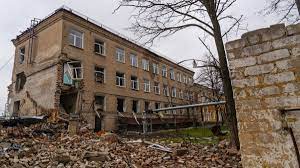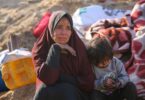Heather Murdock
In the past week, at least three people have died in the shelling that slams both in and out of Chasiv Yar, Ukraine, sometimes every few minutes. City workers say their main job now is to get people, and anything else of value, out. “Many people have already left,” says Yevgeni Dmytriev, 32, the city administrator, when we meet him by his van near the center of town. The local government building is now a distribution point for emergency aid like food and wood to burn for heat. Businesses are closed. Their windows are either boarded up or smashed in.
“Some humanitarian aid is still here,” explains Dmytriev. “We want to move this humanitarian aid from here to a safer place.” Chasiv Yar is about 10 kilometers from the city of Bakhmut, where the longest and deadliest battle in Ukraine is currently taking place. Chasiv Yar is close enough to be hit by artillery aimed at Bakhmut, but it is also a target itself. Every tree-lined block in the city appears to have been bombed and most of the people we see are armed and armored soldiers.
The roads are largely deserted, but tanks and vehicles carrying soldiers into battle whip by from time to time. Across the street, a team of three journalists wearing helmets and blue body armor wander through the city’s central park. At this moment, the nearby blasts are the Ukrainian Army’s artillery firing on Russian forces, but that can change in an instant.
Outside a community shelter about five minutes’ drive away, Alexandr Cverkovich, a 38-year-old aid worker and head of the Peace and Kindness Fund, oversees the delivery of boxes of food and water. He also wears body armor, and he and his colleagues are dressed in camouflage. Early last month, Cverkovich delivered supplies to Bakhmut. Now Chasiv Yar is as close as aid organizations and most journalists can get to the heart of the battle zone. And the conditions in Chasiv Yar are now, in many ways, eerily like those in Bakhmut two months ago, he says. “[Chasiv Yar] is heavily damaged now,” he continues. “Last time we were here it was in one piece.” The community shelters here are called “invincibility points,” providing electricity to charge phones and internet access. About 20% of the population remains in Chasiv Yar, but most city services are not operating. The thousand-plus people still in town are mostly old, sick, poor, or all three. Phone numbers for evacuation teams are printed on small paper handouts in the shelter and hung on the wall, but they are not often called.
This situation was also similar in Bakhmut a few months ago, say aid workers. Back then all the people in Bakhmut who wished to flee were long-gone. But now things are different.
The only way out is by rescue by an armed military unit, and soldiers are busy fighting to hold onto the city and their lives. “We got lucky,” says Svetlana, a 74-year-old former librarian who escaped Bakhmut last week after spending three days trying to wave down soldiers as they passed by, usually fleeing bombings. But Alexandr, a 67-year-old Chasiv Yar resident and shelter volunteer, says he and many others have no plans to leave, despite warnings. In cities, towns and villages across Ukraine’s conflict area, people live under fire in order to care for elderly or sick relatives or neighbors, pets or farm animals. “[My home] was damaged,” he says, matter-of-factly. “The windows were blown out. So we covered them with plastic tarps.”
It is also commonly believed that many civilians who still live in Ukraine’s eastern war zone stay because they support the idea of Russian rule. Besides cross-border familial and cultural bonds, Russian is the most used language here and it’s not hard to find people who are nostalgic for the time of the Soviet Union. But we meet no one living side by side with Ukraine’s defending forces who overtly declares loyalty to Russia’s invading army. While having a cigarette outside the shelter, Vladimir, 80, tells us he is not interested in talking of the Soviet days. But he points out what he perceives as the futility of this war. He says that, in his opinion, neither the United States nor Britain would be able to beat Russia in battle, so he doesn’t believe Ukraine can win now. “Let’s all be friendly,” he says, emphatically repeating the final word in English with his finger pointed.
“Friendly.” While we talk, residents and volunteers continue to move boxes of food into the shelter, and no one even blinks when the nearby artillery is fired. But one blast accompanied by the whistle of incoming weaponry makes a few people start and one woman declare, “It’s normal” as Yan Boechat, our videographer, drops his camera to look for the location of the hit.
It isn’t near enough to endanger us, so he continues his work. Inside the shelter, the lights go off. It is 3 p.m. and the generator needs to rest until morning. There is no electricity, gas or running water in town. The only internet connections are brought in by the army. With the shelter dark for the day, locals begin to make their way home with packets of donated food. Some have bicycles but most are on foot. “I’ve stayed here at home for the whole war,” says Olga, 72, as she prepares to leave the shelter. “But now I am considering evacuation. Maybe.”
VOA







